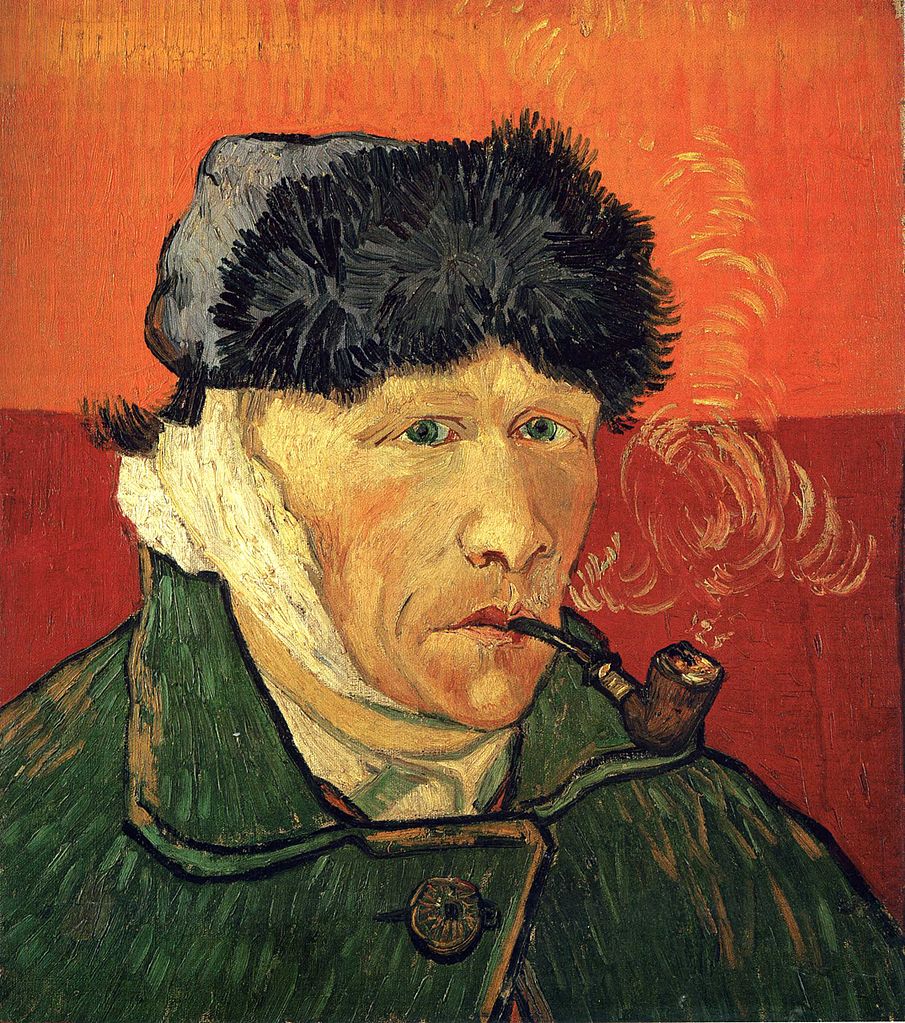Vincent Van Gogh was an admired artist, who was also a troubled and “tortured genius.” His artwork, Starry Night, Bedroom in Arles, and many others have earned him fame and recognition as one of the greatest artists of his time. But what many remember most about this artist is the story of his severed ear. Although his art is exemplary, his struggle with mental health and self-harm is admirable. His struggle was overlooked due to his incredible talent. He was successful as an art dealer, but as an artist, he had to prove himself with the headquarters of international art dealers, Gopil & Cie. During his lifetime, Van Gogh was the poster boy for the image of starving artist. His artwork was not recognized until much later in his career, which could have been a leading cause of his major depression and anxiety.1
Van Gogh, born in the Netherlands, decided to start his career in Paris in the 1880s, where many of the age’s great artists also resided. He believed he could get recognition for his pieces through his younger brother, Theo, who made his living as an art dealer. His brother introduced him to many artists, including Georges Seaurat, Camille Pisatto, and Paul Gauguin. Upon meeting these successful artists, Van Gogh was greatly inspired by their work and began creating his own artistic style, beginning in 1883. Later the same year, Van Gogh rented a small house in Arles, in the south of France. Paul Gauguin and Van Gogh became close friends and later roommates. They consistently bounced ideas off of each other and created a strong friendship.2

Like many friendships, theirs was rocky, and they found themselves drifting apart. Gauguin had moved on to a different artistic style and was exploring other ideas. Van Gogh at the time, had been reciprocating signs of depression and mental health issues, but at the time, these symptoms were considered normal. When Gauguin decided to explore other art spectrums, it involved moving out of the house he and Van Gogh shared. He broke the news to his roommate about his intentions, and this evidently this made Van Gogh go over the edge. He did not take the news lightly and both men began verbally arguing. Van Gogh had disappeared for a few hours and when he returned to confront Gauguin, he had a razor blade in hand threatening to hurt Gauguin.3
During the confrontation, however, Van Gogh was hesitant to hurt his friend and decided to turn the blade on himself and completely cut off his ear. Gauguin left him bleeding and alone. Van Gogh bandaged his head and began drowning himself in alcohol. During this episode, he walked out of his home and into the streets where he found a prostitute. The ear that he had severed off of himself had been neatly wrapped in a cloth; since Van Gogh was still heavily intoxicated, he decided to present this token to the prostitute. Patiently, she ran off and alerted the police about her encounter and they immediately rushed to his home.4
Shortly before Christmas Eve, Van Gogh was found by police in his bed, partially conscious and with major blood loss. Authorities rushed him to the hospital where he surprisingly recovered. Meanwhile, Gauguin was brought into questioning, but gave no testimony on the incident. It was believed that Van Gogh had suffered a severe mental breakdown long before he had severed his ear, but that this created a ripple effect that led to lunacy. The real reason behind the infamous Van Gogh ear-cutting may never be known; Gauguin had promised Van Gogh a pact of silence on the situation in letters that they supposedly exchanged. 5

After the incident, Van Gogh was admitted into a psychiatric facility in hopes of recovering mentally and physically. The dramatic change was not helpful for such a troubled artist, and in July of 1890, Vincent Van Gogh ended his life with a revolver. Before his suicide, however, he created a very iconic painting, Self Portrait with Bandaged Ear 1889. Van Gogh intended to persuade his doctors that he was perfectly able to continue working and creating art by creating this self portrait. He presented his piece, leaving a trail of wonder for his supporters as to why he included certain details in this particular piece, mainly because he continued to paint himself in the same yellow house he and Gauguin shared. Doctors overlooked these details and allowed Van Gogh to leave the facility.6
The epidemy of many artists like Van Gogh is often associated with mental instability, drug use, and alcohol abuse. Van Gogh had an array of medical issues that were tied back to his coping mechanisms (alcohol abuse), and as a result, many did not understand the struggles he faced and degraded him as a person while idolizing his artistic talent. As said before, the real reason behind his mutilated ear will be unclear, but his work and talent will continue to inspire and educate.
- Adam Gopnik, “Van Gogh’s Ear,” The New Yorker, Literature Resource Center (January 4, 2010): 48. ↵
- “Who Really Cut Off Van Gogh’s Ear?” Weekend All Things Considered, Literature Resource Center, (May 2010). ↵
- “Who Really Cut Off Van Gogh’s Ear?” Weekend All Things Considered, Literature Resource Center, (May 2010). ↵
- Belinda Thomson, “Comparing lives: issues of balance in biographical writing,” Literature Resource Center, French Politics, Culture and Society 24, no. 2 (2006): 60. ↵
- Tim Suermondt, “All the Answers.” Literature Resource Ceter, Prairie Schooner 85, no.3 (2011): 47. ↵
- Tim Suermondt, “All the Answers,” Literature Resource Center, Prairie Schooner 85, no. 3 (2011): 47. ↵



170 comments
Sienna Guerra
Finally someone writes an article on one of my favorite artists ever! Vincent Van Gogh was my idol when I was in middle school art. I remember doing a project about him and I learned about the illnesses her had and how his ear got cut off. Schizophrenia is no joke and it can lead to dangerous acts like this but most importantly, he portrayed so many emotions within his art that was appreciated then and even now.
Martina Rodriguez
This Van Gogh does a wonderful job of really painting the picture of the tortured starving artist that we know today was driven to cut off his own ear. While I had actually become familiar with the story of Van Gogh over the years I had never actually heard of the confrontation with Gauguin. I had no idea that was the context for the severed ear.
Jasmine Rocha
The only reason I knew about Van Gough was that of the one episode of Doctor Who but I doubt it was completely historically accurate. In this article you see the reality of Van Gough’s life and how he was mentally ill and how this affected how other saw him and how he saw the world in a different way. Which eventually lead to a mental breakdown and became the now famous missing ear portrait of him.
Annissa Noblejas
It will never truly be known what Van Gogh’s motivation or true intentions were in the circumstances surrounding his severed ear. However, there was a reason his longtime friend Paul Gauguin refused to disclose any details. I suspect there was more going on than over drinking, even as alcohol is a known depressant and can contribute to mental illness episodes. I find it hard to believe a good friend would leave someone severely injured.
Marina Castro
Van Gogh is one of my favorite painters. The knowledge I had about his life was very vague. I knew he was mentally ill but I was not aware of the severity of it. I had seen many times his portrait in which you can see he has a wound on his head. However, I didn’t know it was because of his ear.
Michael Hinojosa
Van Gogh has always been an artist I’ve heard of but never really knew much about. The most fascniating I knew about him was always that he had one ear cut off but I never knew that he was the one who cut it off in the first place so that was of course a huge shocker to hear about when I read this article. But other than already knowing about his missing ear everything in this article is not only interesting but informative as I got to have a bit of a more in-depth experience with this artist than ever before!
Tessa Bodukoglu
I have always been very fond of art and Van Gogh is a very interesting subject. He has created numerous works of art that are very known around the world. I have personally never studied the history of Van Gogh but I have heard of his mental health and how it lead to him removing his ear. I do understand how mental illnesses can affect people but I personally don’t understand how this could lead to him cutting off his own ear.
Robert Freise
Van Gogh was a very influential artist during the Renaissance. the ability to convey so many emotions in his art was very interesting for many people during this time. It gave the community a futuristic array on how art could be used for more than representing a picture. The whole incident with him cutting off his own ear baffled many during this time, because mental illness was described as a devil taking over your soul during this time. So, I am almost certain that people bashed on Van Gogh for that. He might have been Schizophrenic and that’s why he cut of his own ear. Great article!!
Alexandra Rodriguez
Van Gogh is one of my favorite artists of all time. Seeing his art in person for the first time in Houston’s Art Museum made me melt into awe as I was looking at one of my artistic idol’s work. I have always been involved in art and I have loved Van Gogh since I was little. However, I always heard that he had cut his ear off due to schizophrenia, not because of a mental breakdown. This new information is so amazing and it makes me adore his work even more.
Mia Stahl
It is always sad to think about how troubles most geniuses of art often are. This is a reoccurring issue throughout history, and it is a shame that most people view the severing of his ear more as a meme rather than a very real effect of mental illness. This article was very intriguing because it takes a commonly referred to event in history and gives us much more information than what is usually provided.